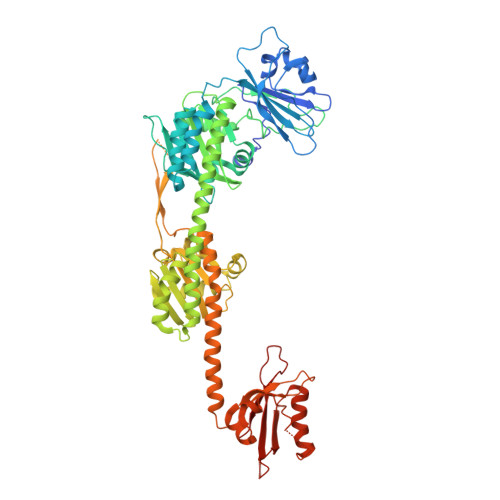Structure of the Full-Length Bacteriophytochrome from the Plant Pathogen Xanthomonas Campestris Provides Clues to its Long-Range Signaling Mechanism.
Otero, L.H., Klinke, S., Rinaldi, J., Velazquez-Escobar, F., Mroginski, M.A., Lopez, M.F., Malamud, F., Vojnov, A.A., Hildebrandt, P., Goldbaum, F.A., Bonomi, H.R.(2016) J Mol Biol 428: 3702
- PubMed: 27107635
- DOI: https://doi.org/10.1016/j.jmb.2016.04.012
- Primary Citation of Related Structures:
5AKP - PubMed Abstract:
Phytochromes constitute a major superfamily of light-sensing proteins that are reversibly photoconverted between a red-absorbing (Pr) and a far-red-absorbing (Pfr) state. Bacteriophytochromes (BphPs) are found among photosynthetic and non-photosynthetic bacteria, including pathogens. To date, several BphPs have been biophysically characterized. However, it is still not fully understood how structural changes are propagated from the photosensory module to the output module during the signal transduction event. Most phytochromes share a common architecture consisting of an N-terminal photosensor that includes the PAS2-GAF-PHY domain triad and a C-terminal variable output module. Here we present the crystal structure of the full-length BphP from the plant pathogen Xanthomonas campestris pv. campestris (XccBphP) bearing its photosensor and its complete output module, a PAS9 domain. In the crystals, the protein was found to be in the Pr state, whereas diffraction data together with resonance Raman spectroscopic and theoretical results indicate a ZZZssa and a ZZEssa chromophore configuration corresponding to a mixture of Pr and Meta-R state, the precursor of Pfr. The XccBphP quaternary assembly reveals a head-to-head dimer in which the output module contributes to the helical dimer interface. The photosensor, which is shown to be a bathy-like BphP, is influenced in its dark reactions by the output module. Our structural analyses suggest that the photoconversion between the Pr and Pfr states in the full-length XccBphP may involve changes in the relative positioning of the output module. This work contributes to understand the light-induced structural changes propagated from the photosensor to the output modules in phytochrome signaling.
Organizational Affiliation:
Fundación Instituto Leloir-IIBBA-CONICET, Av. Patricias Argentinas 435 (C1405BWE), Buenos Aires, Argentina; Plataforma Argentina de Biología Estructural y Metabolómica PLABEM, Av. Patricias Argentinas 435 (C1405BWE), Buenos Aires, Argentina.

















